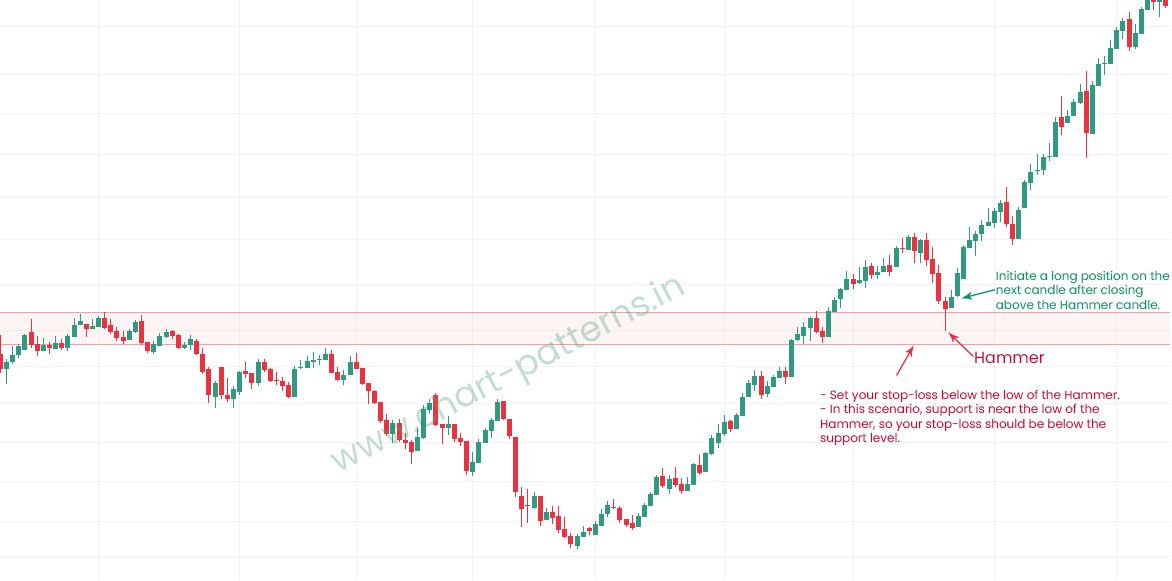Candlestick Patterns - Bullish Candlestick Patterns
Hammer
The Hammer candlestick pattern is a key reversal signal in technical analysis, normally forming this pattern after a downtrend. This pattern is formed with a small body located at the upper end of the trading range, with a long lower wick that is at least twice the length of the body. Here we learn how to identify and trade the Hammer pattern to enhance your trading strategy and improve your chances of success.
Let's explore the characteristics of the Hammer pattern and learn how to identify this pattern and how to trade this strategy.
What is the Hammer Candlestick Pattern?
The Hammer candlestick pattern represents a potential reversal in price direction. It indicates that despite selling pressure during the trading session, buyers managed to push the price back up, closing near the open. This behavior suggests a shift in market sentiment from bearish to bullish.
Key Features of the Hammer Pattern
- Small Body: The body of the Hammer is relatively small and can be either bullish (green or white) or bearish (red or black).
- Long Lower Wick: The lower wick should be at least twice the length of the body, illustrating significant buying pressure after a decline.
- Location: The Hammer appears after a downtrend, signaling a potential reversal.
How to Identify the Hammer Pattern
Structure of the Hammer
- Downtrend Preceding the Hammer: Look for a clear downtrend in price action leading up to the formation of the Hammer.
- Formation of the Candlestick: The price opens lower, trades down, but then rallies to close near the opening price, forming the Hammer with a long lower wick.
- Volume Consideration: Volume accompanying the Hammer can provide further confirmation of the reversal. Higher volume during the formation of the Hammer increases its significance.
Types of Hammers
- Regular Hammer: This appears in a downtrend and signals a bullish reversal.
- Inverted Hammer: This appears after a downtrend and can also indicate a potential bullish reversal, although it is more ambiguous.
Trading the Hammer Candlestick Pattern
Entry Strategy
- Entry After Confirmation: Enter a trade when the price breaks above the high of the Hammer candlestick. This breakout confirms the reversal signal.
Setting Stop Loss
- Stop Loss Placement: Set your stop loss below the low of the Hammer. This protects against false breakouts and helps manage risk.
Determining Target Price
- Target Calculation: Measure the distance from the open to the high of the Hammer and project this distance upward from the breakout point to establish your target price.

Example Calculation
If the Hammer has a high of $50 and a low of $40, with the closing price at $45, measure the distance from the low to the high ($10). If the price breaks above the Hammer at $50, set your target at $60 ($50 + $10).
Risk Management in Trading
Importance of Risk-Reward Ratio
Implementing a solid risk management strategy is crucial for successful trading. Aim for a risk-reward ratio of at least 1:2 or better. For example, if your stop loss is set at $3 below your entry, target a price that is at least $6 above your entry.
Position Sizing
Determine your position size based on your overall trading strategy and risk tolerance. Proper position sizing helps manage exposure and ensures that no single trade has a detrimental impact on your capital.
Tips for Successful Trading
-
Use Additional Indicators: Incorporate other technical indicators, such as RSI (Relative Strength Index) or MACD (Moving Average Convergence Divergence), to confirm bullish momentum and enhance your trading decisions.
-
Assess Market Context: Always consider the overall market conditions; the Hammer pattern is more effective in bullish market environments. Understanding broader market trends can enhance your trading success.
-
Be Patient: Wait for confirmation of the bullish reversal after the Hammer before entering a trade. Avoid rushing into trades to minimize losses.
Example Trade Setup
-
Identify the Pattern: Look for the formation of a Hammer on a daily chart following a downtrend.
-
Confirm with Volume: Ensure that the volume during the formation of the Hammer is significant.
-
Enter the Trade: Once the price breaks above the high of the Hammer at $50 with strong volume, enter a long position.
-
Set Stop Loss: Place your stop loss at $39 (below the low of the Hammer).
-
Determine Target Price: Measure the height of the Hammer ($10) and set your target price at $60 ($50 + $10).
Conclusion
The Hammer candlestick pattern is a powerful tool for traders looking to identify potential bullish reversals after a downtrend. By following a systematic approach to identifying the pattern, managing risk effectively, and confirming with volume and other indicators, you can enhance your trading strategy and increase your chances of success. Always practice sound risk management and adapt your strategy based on prevailing market conditions. Happy trading!
Disclaimer: This article is for educational purposes only and should not be considered financial advice. Read our full disclaimer.
